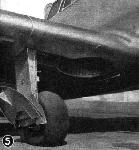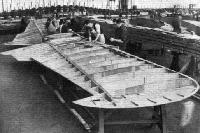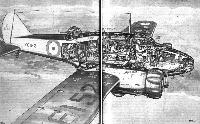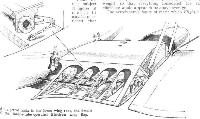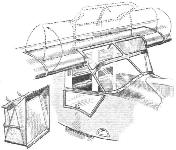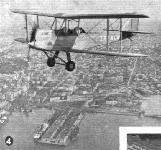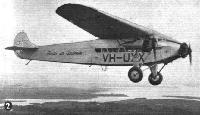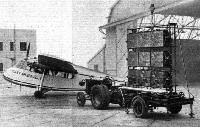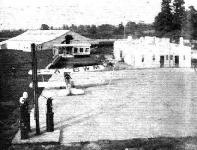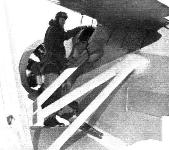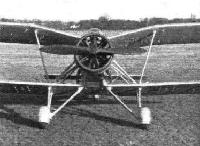Фотографии
-
The Fokker D.XXI fighter seen in this Flight sketch has a radial engine, but the liquid-cooled type, such as the 860 h.p. Hispano Suiza Ycrs canon engine may be fitted. With that power plant a speed of 273 m.p.h. is attained.
Самолёты на фотографии: Fokker D.XXI - Нидерланды - 1936
-
SLEEPER TRANSPORT: The new Douglas D.S.T., which will carry sixteen passengers as a "sleeper transport" and twenty-four in the ordinary way, on test at Santa Monica, California. With two 930 h.p. engines - presumably the latest Wright Cyclones - the D.S.T. has a maximum speed of approximately 215 m.p.h.
Самолёты на фотографии: Douglas DC-3 / C-47 Skytrain/С-53 Skytrooper / Dakota - США - 1935
-
Регистрационный номер: K5083 OUTSTANDING MILITARY TYPE. The fastest produced during the year was the Hawker monoplane, which, fitted with a Rolls-Royce Merlin engine, is now being tested.
Самолёты на фотографии: Hawker Hurricane - Великобритания - 1935
-
Регистрационный номер: ZS-AFD [2] Passengers disembarking from a South African Airways Junkers Ju. 52 at the Rand Airport.
Самолёты на фотографии: Junkers Ju.52/3m - Германия - 1931
-
Регистрационный номер: ZS-AFD [2] South African Airways Ju. 52 passing over the wattle plantations of Natal.
Самолёты на фотографии: Junkers Ju.52/3m - Германия - 1931
-
The Potez 54 (four 800 h.p. Mistral Majors);
Самолёты на фотографии: Potez Potez 54 - Франция - 1933
-
A Wright Cyclone of 750 h.p. is fitted to the new Vultee V-11 attack bomber. In this view the cowling has been removed and the exhaust system and several other items are visible.
Самолёты на фотографии: Vultee V-11 - США - 1935
-
Details of the wing structure and the operating mechanism for one-half of the undercarriage. Retraction is effected either manually or electrically by a system of torque shafts and bevel gears driving a worm and gear quadrant mechanism attached to the upper end of each undercarriage strut.
Самолёты на фотографии: Vultee V-11 - США - 1935
-
The tail cone and fin structure is a unit removable from the fuselage
Самолёты на фотографии: Vultee V-11 - США - 1935
-
A sturdy inwardly-retracting undercarriage is not the least interesting feature. Shock absorption is obtained by means of oleo legs, rubber taxying pads and air wheels.
Самолёты на фотографии: Vultee V-11 - США - 1935
-
The long "conservatory" is the most striking feature of the machine.
Самолёты на фотографии: Vultee V-11 - США - 1935
-
The gunner occupies the rear portion of the long cockpit enclosure. This view shows the mounting for his Browning gun.
Самолёты на фотографии: Vultee V-11 - США - 1935
-
Mr. Robert Loraine at a Bournemouth meeting in 1910.
Самолёты на фотографии: Farman Farman-IV - Франция - 1910
-
Регистрационный номер: D-AHAO D.L.H. SPEED UP: The new twin-engined Heinkel, which has a top speed of 214 m.p.h. With more powerful engines, as will be fitted to a batch of the machines expected to go into service this summer, over 254 m.p.h. is hoped for, with a cruising speed of 217 m.p.h. It is fitted with flaps and a retractable undercarriage.
Самолёты на фотографии: Heinkel He-111 - Германия - 1935
-
With its present 660 h.p. engines the new Heinkel has a top speed of 214.37 m.p.h.; Over 254 m.p.h. is expected when the 880 h.p. units are fitted.
Самолёты на фотографии: Heinkel He-111 - Германия - 1935
-
MY LADY NICOTINE will be welcomed as a passenger in the new twin-engined Heinkel; this is the smoking compartment.
Самолёты на фотографии: Heinkel He-111 - Германия - 1935
-
The "non-smoking" section of the cabin.
Самолёты на фотографии: Heinkel He-111 - Германия - 1935
-
This British machine is the subject of large Air Ministry contract: the Handley Page Heyford. This type, as at present being built, mount the 600-h.p. Rolls-Royce Kestrel VI, which is supercharged to give that power at 11,000 ft.
Самолёты на фотографии: Handley Page Heyford / H.P.38 / H.P.50 - Великобритания - 1930
-
A NEW SPECIES: Everyone knows the Fairey Fox as a swift, slinky two-seater. Now the Belgian Fairey Company have turned out a single-seater Mark VII Fox and have called it the Kangaroo. Whether this is because of the increased punching ability conferred by four machine guns or because of the prominent pouch beneath the fuselage (to cool the 860 h.p- Hispano Y) is not definitely known.
Самолёты на фотографии: Fairey Fox IIIC/VIC - Бельгия - 1933
-
Регистрационный номер: K2059 A SERVICE RECORD: Figures recently issued by the Air Ministry show that the flying time of the machines engaged in the 1935 Air Exercises aggregated 3,839 1/2 hours, which is an increase of 37 per cent, over the figures for 1934. High-altitude fighting was an outstanding feature, combats between light bombers and fighters being fought at about 21,000 ft. This photograph taken during the Exercises, shows such an engagement. The fighters are Furies and the picture was secured from a Gordon.
Самолёты на фотографии: Fairey Gordon / Seal - Великобритания - 1931Hawker Fury - Великобритания - 1931
-
The new medium bomber Vickers Wellesley (Bristol Pegasus XVIII) is a remarkable example of the manner in which geodetic construction makes possible a high aspect ratio coupled with low structure weight.
Самолёты на фотографии: Vickers Wellesley - Великобритания - 1935
-
A DOUGLAS BOMBER. This is the high-speed, long-range Douglas entered in the U.S. Army Air Corps competition with the ill-fated Boeing 299 and the new Martin. It bears resemblance in certain features, notably the undercarriage, to the D.C.2 commercial machine.
Самолёты на фотографии: Douglas B-18 Bolo - США - 1935
-
The Martin B-10 bomber has met with extraordinary success. With two Wright Cyclone engines of over 700 h.p. a speed of 215 m.p.h. is attained. An improved type is at present the subject of Air Corps experiments.
Самолёты на фотографии: Martin B-10 / Type 139 / 166 - США - 1932
-
The Farman F-221 (four 800 h.p. Mistral Majors);
Самолёты на фотографии: Farman F.220 / F.221 / F.222 - Франция - 1932
-
IN THE EAST: A striking picture of a flight of three Hawker machines of No. 208 (Army Co-operation) Squadron flying over Cairo. This squadron is stationed at Heliopolis and is the only one of that class in the Middle East Command. It has been stated that the concentration of Italian troops and Air Force units in Libya is regarded as a possible menace to Egypt, in case Signor Mussolini should decide that some sanctions constituted a casus belli. Sir Samuel Hoare, however, made mention of British reinforcements in Egypt, Malta and Aden.
Самолёты на фотографии: Hawker Audax - Великобритания - 1931
-
The Breda 65 is a new "assault" type developed in Italy. It has a Gnome-Rhone Mistral Major engine of 800 h.p. and a maximum speed in the region of 250 m.p.h.
Самолёты на фотографии: Breda Ba.65 - Италия - 1935
-
Регистрационный номер: D-AHIS FOR SOUTHERN SERVICE: The Monsun, first of the Dornier Do. 18 boats for the German South Atlantic mail service. A range of 2,765 miles is claimed at a cruising speed of 124 m.p.h. Two 500/560 h.p. Junkers Jumo diesels are fitted, the rear one driving its propeller through shafting.
Самолёты на фотографии: Dornier Do.18 - Германия - 1935
-
A single-seater fighter flying boat: this striking snapshot shows the new Potez 453 under test. It will be interesting to see how it compares with twin-float seaplanes in carrying out the duties for which it is intended.
Самолёты на фотографии: Potez Potez 45 / 452 - Франция - 1932
-
Регистрационный номер: K6152 [3] THE ADMIRABLE ANSON: Lord Anson did much in his day to improve the fighting efficiency of the Royal Navy; and the Avro Anson coastal reconnaissance machine, harbinger of hordes of monoplanes and first of its class in the Royal Air Force, will greatly assist the work of the senior Service in protecting our shores. This Flight photograph shows the first of a very large number of Ansons which will be going to Squadrons within the next few months.
Самолёты на фотографии: Avro Anson / Type 652 - Великобритания - 1935
-
Регистрационный номер: K6152 [3] ARMCHAIR FIGHTING. The disposition of the Anson's Armstrong-Whitworth gun turret is readily apparent here. Note the spacious, airy cabin
Самолёты на фотографии: Avro Anson / Type 652 - Великобритания - 1935
-
Some idea of the size and the nature of the construction of the wing may be gathered from this view.
Самолёты на фотографии: Avro Anson / Type 652 - Великобритания - 1935
-
Регистрационный номер: K6152 [3] Mr. S. A. Thorn lowers the undercarriage of the first production type Anson for the benefit of Flight's photographer
Самолёты на фотографии: Avro Anson / Type 652 - Великобритания - 1935
-
The rear portion of the roomy cabin (without its complete equipment) and the door leading into the A.W. gun turret.
Самолёты на фотографии: Avro Anson / Type 652 - Великобритания - 1935
-
The forward portion of the cabin.
Самолёты на фотографии: Avro Anson / Type 652 - Великобритания - 1935
-
In this Flight drawing by Max A. Millar, the majority of the military equipment carried by the Avro Anson (two 310 h.p. Siddeley Cheetah) over water reconnaissance is visible. The figure shown dotted represents the navigator in his alternative position, where he acts as bomb-aimer. Note, in the nearest engine nacelle, the dinghy which is instantly inflated automatically should the machine make a forced landing on water. The complete bomb load is not shown: actually this consists of two 100-lb, bombs and four or eight twenty-pounders. The breech of the fixed Vickers gun is just visible to the left of the pilot.
Самолёты на фотографии: Avro Anson / Type 652 - Великобритания - 1935
-
Avro Anson
Самолёты на фотографии: Avro Anson / Type 652 - Великобритания - 1935
-
FIRST OFF THE LINE: Here is the first production-type Fairey Swordfish torpedo spotter reconnaissance machine during tests at the Fairey aerodrome last week. The Swordfish is fitted with the 690 h.p. Bristol Pegasus III moderately supercharged radial: its airscrew is a three-bladed metal Fairey.
Самолёты на фотографии: Fairey Swordfish - Великобритания - 1934
-
SPANISH-BUILT: Some of the Spanish Air Force Vickers Vildebeest torpedo-bombers under construction at the Getafe, Madrid, works of Construcciones Aeronauticas S.A., who are building them under licence from Vickers (Aviation) Ltd. Twenty-six have recently been completed, with wheel undercarriages, while conversion sets to enable the machines to be used as twin-float seaplanes have also been produced by the C.A.S.A. Hispano Suiza engines are fitted. It is stated that the naval authorities, in particular, are extremely pleased with the Vildebeests.
Самолёты на фотографии: Vickers Vildebeest / Type 132 - Великобритания - 1928
-
PANORAMA OF THE PYRAMIDS. Many aerial photographs of the Pyramids have been taken and published, but there is novelty in the extensive view shown in this picture, taken from one of the bomber-transport machines of No. 216 (B.T.) Squadron, which is stationed at Heliopolis. The whole array of Pyramids is seen, while the arrow points out the location of the Sphinx. The recent excavations round the base of that mysterious monument can be discerned. The considerable town in the neighbourhood is also interesting.
Самолёты на фотографии: Vickers Valentia - Великобритания - 1934
-
Самолёты на фотографии: Avro Tutor/Sea Tutor/Prefect / Type 621/646/626 - Великобритания - 1929
-
THESE photographs, secured by Flight's photographer at Hatfield, show some of the features of the first D.H.86a. Two versions of this type are actually being produced, one with standard Gipsy Six engines and wooden airscrews, and the other with Series II "Sixes" driving De Havilland controllable-pitch airscrews. These pictures show the former model. In this view may be seen the muffs on the exhaust pipes for cabin heating purposes.
Самолёты на фотографии: De Havilland Express Air Liner / D.H.86 - Великобритания - 1934
-
HIGH AND DRY: While the Jersey-bound D.H.86 flies serenely on its way, a Dutch freighter makes heavy weather in the Channel. A picture taken last week by a member of the staff of Flight.
Самолёты на фотографии: De Havilland Express Air Liner / D.H.86 - Великобритания - 1934
-
The view shows Venturis mounted within the leading edge
Самолёты на фотографии: De Havilland Express Air Liner / D.H.86 - Великобритания - 1934
-
One half of the undercarriage which now embodies Turner compressed-air shock-absorber struts, more powerful brakes, and reinforced tyres. The disposable load of the machine as shown is 4,110 lb., whereas that of the previous 86 was 3,680 lb.
Самолёты на фотографии: De Havilland Express Air Liner / D.H.86 - Великобритания - 1934
-
Регистрационный номер: G-ADIS OUTSTANDING CIVIL TYPE: The De Havilland Hornet Moth (130 h.p Gipsy Major) side-by-side two-seater.
Самолёты на фотографии: De Havilland Hornet Moth / D.H.87 - Великобритания - 1934
-
Mr. J. C. C. Taylor, one of the aviation representatives of Shell-Mex and B.P. Ltd. in the cabin of the new Hornet Moth of which the company has recently taken delivery.
Самолёты на фотографии: De Havilland Hornet Moth / D.H.87 - Великобритания - 1934
-
Регистрационный номер: G-ADNA "Throwing it About": Mr. H. Buckingham gives the D.H.90 a thorough try-out above the clouds.
Самолёты на фотографии: De Havilland Dragonfly / D.H.90 - Великобритания - 1935
-
Самолёты на фотографии: De Havilland Dragonfly / D.H.90 - Великобритания - 1935
-
Ample room everywhere and a noise level reduced to the neighbourhood of 70 decibels are features of the D.H.90 cabin. The accommodation provides for pilot and four passengers, one seated next to the pilot. Note the dual flying controls. An extra petrol tank of 25 gallons capacity is installed under the rear seat.
Самолёты на фотографии: De Havilland Dragonfly / D.H.90 - Великобритания - 1935
-
The D.H.90 Dragonfly shown partly "in skeleton."
Самолёты на фотографии: De Havilland Dragonfly / D.H.90 - Великобритания - 1935
-
The lower wing roots of the D.H.90 are of thick section, and in addition to carrying the wing bracing as cantilever beams they contain the two main petrol tanks, each of 30 gallons capacity, and also carry the engine mountings and undercarriage structure.
Самолёты на фотографии: De Havilland Dragonfly / D.H.90 - Великобритания - 1935
-
Outer wing strut attachments of the Dragonfly, with incidence adjustment.
Самолёты на фотографии: De Havilland Dragonfly / D.H.90 - Великобритания - 1935
-
Details of lower wing root, engine mounting and undercarriage attachment.
Самолёты на фотографии: De Havilland Dragonfly / D.H.90 - Великобритания - 1935
-
One of the petrol tanks in the lower wing root, and details the torque-tube-operated Elektron wing flap.
Самолёты на фотографии: De Havilland Dragonfly / D.H.90 - Великобритания - 1935
-
D.H.90
Самолёты на фотографии: De Havilland Dragonfly / D.H.90 - Великобритания - 1935
-
This British machine is the subject of large Air Ministry contract: the Fairey Hendon. This type, as at present being built, mount the 600-h.p. Rolls-Royce Kestrel VI, which is supercharged to give that power at 11,000 ft.
Самолёты на фотографии: Fairey Hendon - Великобритания - 1930
-
OUTSTANDING CIVIL TYPE: One of four machines which made their first appearance during 1935: (2) the Heston Phoenix five-seater with 200 h.p. Gipsy Six;
Самолёты на фотографии: Heston Phoenix - Великобритания - 1935
-
The cabin of the Vega Gull is 44 in. wide and permits side-by-side seating without cramping.
Самолёты на фотографии: Percival Vega Gull / K.1 - Великобритания - 1935
-
An improved wing-folding arrangement has been introduced on the Vega Gull. It embodies a tommy bar (which disappears inside the wing) in place of the old fixed handle.
Самолёты на фотографии: Percival Vega Gull / K.1 - Великобритания - 1935
-
Регистрационный номер: G-AEAD OUTSTANDING CIVIL TYPE: One of four machines which made their first appearance during 1935: (3) the Percival Vega Gull four-seater with Gipsy Six;
Самолёты на фотографии: Percival Vega Gull / K.1 - Великобритания - 1935
-
Despite the fact that the Vega Gull has the same power plant as last year's three-seater Gull it carries its four passengers at 170 m.p.h. Capt. Percival, in fact, says that the maximum speed is a shade over this figure.
Самолёты на фотографии: Percival Vega Gull / K.1 - Великобритания - 1935
-
Say "Ah!" Capt. E. W. Percival, designer of the Vega Gull, inspects the flaps (which are of greater area than those of the Gull) on the machine he demonstrated at Gravesend.
Самолёты на фотографии: Percival Vega Gull / K.1 - Великобритания - 1935
-
One half of the simplified undercarriage is revealed
Самолёты на фотографии: Percival Vega Gull / K.1 - Великобритания - 1935
-
General arrangement of the Vega Gull.
Самолёты на фотографии: Percival Vega Gull / K.1 - Великобритания - 1935
-
Регистрационный номер: G-ADXL [3] The business end of the Hillson Praga, showing the engine and its exhaust system (with heater muff) and the divided undercarriage.
Самолёты на фотографии: Praga E-114 Air Baby / E-115 / E-117 - Чехословакия - 1934
-
Регистрационный номер: G-ADXL [3] Самолёты на фотографии: Praga E-114 Air Baby / E-115 / E-117 - Чехословакия - 1934
-
Регистрационный номер: G-ADXL [3] The clean and handsome lines of the Praga are effectively shown in this photograph.
Самолёты на фотографии: Praga E-114 Air Baby / E-115 / E-117 - Чехословакия - 1934
-
How the leading edge and part of the windscreen are folded back for entry into the cockpit. To the left is shown one of the fitted haversacks for light luggage. These lie behind the seat-backs, which are designed to accommodate either cushions or back-type parachute packs.
Самолёты на фотографии: Praga E-114 Air Baby / E-115 / E-117 - Чехословакия - 1934
-
THE TRANSATLANTIC LOIRE. This Flight sketch gives some idea of the appearance of the Loire 102 flying boat being built for the French South Atlantic service. It should be flying by April and is being fitted with four Hispano series X twelve-cylinder water-cooled engines of approximately 700 h.p. each. The cruising speed should be close to 165 m.p.h. with four passengers, 1,430 lb. of mail and fuel for a range of 2,640 miles.
Самолёты на фотографии: Loire Loire 102 Bretagne - Франция - 1936
-
CONTINENTAL: This is the one of most recent French efforts at building thirty-passenger transports. It was designed to meet the requirements of Air France. The Bloch 300 or "Pacifique" has three Gnome-Rhone Mistral Majors, moderately supercharged to give 880 h.p. at 6,500 feet. Maximum speed is estimated to be in the neighbourhood of 220 m.p.h.
Самолёты на фотографии: Bloch MB.300 Pacifique - Франция - 1935
-
CONTINENTAL: This is the one of most recent French efforts at building thirty-passenger transports. It was designed to meet the requirements of Air France. The Dewoitine D-620 has three Gnome-Rhone Mistral Majors, moderately supercharged to give 880 h.p. at 6,500 feet. Maximum speed is estimated to be in the neighbourhood of 220 m.p.h.
Самолёты на фотографии: Dewoitine D.332 / D.333 / D.338 / D.620 - Франция - 1933
-
The new Breguet 460 (two 800 h.p. Mistral Majors);
Самолёты на фотографии: Breguet Br.460 Vultur - Франция - 1935
-
Регистрационный номер: F-ANCF The Caudron Simoun. This is the machine which visited Lympne this summer, and is similar to that used on the Paris-Madagascar flight.
Самолёты на фотографии: Caudron C.500 / C.520 / C.620 / C.630 Simoun - Франция - 1934
-
OVER ETHIOPIA: Apart from the unpleasant fate which is alleged to await Italian pilots who make forced landings in Abyssinian territory, the terrain suggests that the forced landing itself may be sanguinary enough. The machine - one of the "Disparata" squadron - is a Caproni 101.
Самолёты на фотографии: Caproni Ca.101 - Италия - 1930
-
The latest U.S. Navy fighter to go into service is the Grumman F2F-1 shown here. It is powered with a 650 h.p. Pratt and Whitney Twin Wasp Junior.
Самолёты на фотографии: Grumman F2F - США - 1933
-
OUTSTANDING CIVIL TYPE: One of four machines which made their first appearance during 1935: (4) the Miles Merlin five-seater with Gipsy Six.
Самолёты на фотографии: Miles Merlin / M.4 - Великобритания - 1935
-
COMDR. H. T. WHITE, aviation manager of the Vacuum Oil Co., with the new B.A. Eagle which the company has purchased. The equipment includes sound-proofing by Rumbolds.
Самолёты на фотографии: British Klemm BK-1 Eagle - Великобритания - 1934
-
There is no doubt, in this photograph, about the Breguet gyroplane being completely air-borne and as they used to say in the old days, "in full flight." A speed of 62 m.p.h. has been attained.
Самолёты на фотографии: Breguet-Dorand Gyroplane - Франция - 1933
-
HOME FROM THE STRAFE. Eighteen Curtiss A-12 attack monoplanes (700 h.p. Cyclone F) of the United States Army, land simultaneously at the eighth annual all-American air manoeuvres at Miami, Florida. The bulbous object beneath the fuselage of each machine may be either a long-range tank or a bomb.
Самолёты на фотографии: Curtiss A-8 / A-12 Shrike - США - 1931
-
THREE DAYS TO CHILE. Air France inaugurated its South Atlantic mail service last Saturday. On the picture is a scene at Croydon on Saturday, with the mail being loaded into a Wibault-Penhoet for the first stage.
Самолёты на фотографии: Wibault Wibault 280 - Франция - 1930
-
Регистрационный номер: ZK-ACM The Auckland Aero Club's Avian (Hermes II) flying over Auckland.
Самолёты на фотографии: Avro Avian / Type 594/616 - Великобритания - 1926
-
Регистрационный номер: VH-UXX Faith in Australia, the veteran Avro Ten of Tasman Sea fame, over Auckland.
Самолёты на фотографии: Avro Ten / Type 618 - Великобритания - 1928
-
A pioneer type in the development of the modern long-range high-speed bombing monoplane, this Boeing, built five or six years ago, was capable of 180 m.p.h.
Самолёты на фотографии: Boeing B-9 - США - 1931
-
The prototype Consolidated P-30 two-seater pursuit with Curtiss Conqueror engine. The type has been adopted by the U.S. Army Air Corps.
Самолёты на фотографии: Consolidated P-25 / P-30 / PB-2 - США - 1932
-
The Dornier Do.Y bomber did 155 m.p.h. with three Jupiters of an old type.
Самолёты на фотографии: Dornier Do.F/Do.P/Do.Y/Do.11 - Германия - 1930
-
A.G.E.C floodlight, mounted as a mobile unit, in use at the Brighton, Hove and Worthing municipal airport.
Самолёты на фотографии: Short Scion / S.16 - Великобритания - 1933
-
Выкатка первого опытного самолета
The experimental Boeing 299 (four Pratt and Whitney Hornets), which, entered in competition with a new Martin and Douglas, was destroyed in a crash - through no fault of its own - some weeks back. It is said that the crash was caused through the pilots taking off with locked controls. According to one report the 299 has been adopted by the U.S. Army Air Corps.Самолёты на фотографии: Boeing B-17 Flying Fortress - США - 1935
-
Регистрационный номер: K3585 [2] Installation of the turret in the tail of the A.W. XXIII.
Самолёты на фотографии: Armstrong Whitworth A.W.23 - Великобритания - 1935
-
Регистрационный номер: K3585 [2] OUTSTANDING 1935 MILITARY TYPE. The A.W. XXIII is a new bomber transport with two 760 h.p. Tiger VI engines.
Самолёты на фотографии: Armstrong Whitworth A.W.23 - Великобритания - 1935
-
These diagrams show the method of operation of the A.W. turret. The gunner stands to fire downwards.
Самолёты на фотографии: Armstrong Whitworth A.W.23 - Великобритания - 1935
-
OUTSTANDING MILITARY TYPE. The H.P. 51 bomber transport (two 760 h.p. Tiger VI) has slotted flaps which give it a wide speed range.
Самолёты на фотографии: Handley Page H.P.51 - Великобритания - 1935
-
FOUR-MOTOR NIGHT BOMBER. Photographed in 1933, immediately after final erection, but before service roundels applied, is this "one-off" French prototype, the Potez Type 41 Bn4, which was succeeded by the later Potez Type 54. The two pairs of pylon-mounted Hispano-Suiza 12 Ybrs engines delivered a total of 3,360 h.p., giving a max. speed of 199 m.p.h. for a.u.w. of 37,480 lb. at 13,120 ft. Its undercarriage was retractable.
Самолёты на фотографии: Potez Potez 41 - Франция - 1934
-
Регистрационный номер: G-ADUA PRACTICAL PROOF: On December 20 Mr. Robert Kronfeld delivered a B.A.C. Super Drone to Holland and flew well over 200 miles non-stop in the process. He left Hanworth at 10.30, cleared Customs at Croydon and landed eventually at Zierikzee, some twenty miles from Rotterdam. The weather was foggy and cold, but, with the new exhaust-warmed induction system, no trouble was experienced. In this photograph the Super Drone is being demonstrated by Mr. Kronfeld at Schiphol, Amsterdam.
Самолёты на фотографии: Kronfeld Drone - Великобритания - 1932
-
The S.P.C.A. 30 M.4 (two 650 h.p. Lorraines). It is considerably older than the other machines but is interesting because its tail is carried on two booms.
Самолёты на фотографии: SPCA Type 30 - Франция - 1931
-
Регистрационный номер: G-ABWM Bristol airport is an example of club and municipal co-operation. This snap shows the clubhouse, passenger station (in course of erection) and Airwork service hangar.
Самолёты на фотографии: De Havilland Gipsy Moth / Moth X - Великобритания - 1928
-
Регистрационный номер: G-ACJJ Самолёты на фотографии: Short Scylla / L.17 - Великобритания - 1934
-
The Bordelaise A.B.80 with a pair of 860 h.p. Hispano Y's;
Самолёты на фотографии: SAB (Bordelaise) AB-80 - Франция - 1934
-
THE FIRST OF A SERIES: On his first flight with his new Cambridge sailplane, the Duke of Grafton (right) obtained his "C" certificate. This machine, designed and built by Zander and Weyl, is the first of a small series and has already proved itself with soaring flights of more than an hour's duration.
Самолёты на фотографии: Dart Cambridge - Великобритания - 1935
-
Certain particulars of the little Rasmussen IIa racer are given on this page. It does 142 m.p.h. on 40 h.p. and will eventually do better than that.
Самолёты на фотографии: Rasmussen Skippy - США - 1933
-
Home-built at Auckland: The Tui (45 h.p. Szekely S.R.3); constructor, Mr. Fred North; tested by Mr. Allan McGruer; flown for photograph by F/O. R. A. Kirkup, of East Coast Airways; top speed, 90 m.p.h.
Самолёты на фотографии: North Tui Sports - Новая Зеландия - 1934
-
Регистрационный номер: K2772 [5] Parnall G4/31 general purpose biplane. A general impression;
Самолёты на фотографии: Parnall G.4/31 - Великобритания - 1934
-
Регистрационный номер: K2772 [5] FOR GENERAL PURPOSES: Built to the Air Ministry specification G.4/31, this Pegasus-engined Parnall Biplane is in the General Purpose class and can be used for precision and dive bombing, torpedo dropping, etc. It embodies numerous unorthodox features.
Самолёты на фотографии: Parnall G.4/31 - Великобритания - 1934
-
Регистрационный номер: K2772 [5] Captain H. J. Saint, who his put the machine through its tests at Yate;
Самолёты на фотографии: Parnall G.4/31 - Великобритания - 1934
-
Регистрационный номер: K2772 [5] The arrangement of the Pegasus engine, "gull" type upper stub wings and wide undercarriage
Самолёты на фотографии: Parnall G.4/31 - Великобритания - 1934
-
Регистрационный номер: K2772 [5] Propulsive effort by members of the ground staff. Note in this picture the pilot's enclosed cockpit.
Самолёты на фотографии: Parnall G.4/31 - Великобритания - 1934
Статьи
- Flight
- Flight Advertisements









